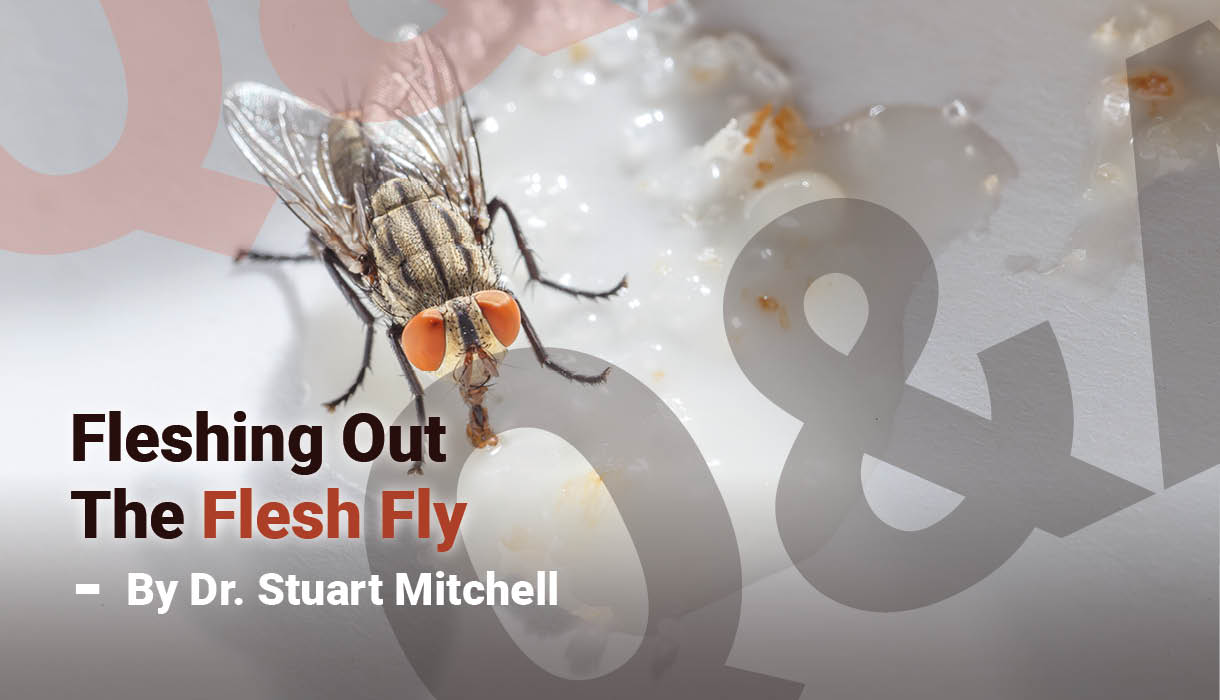In demystifying the intricate world of the Flesh fly, Sarcophaga spp. (meaning “eat flesh”), we discover a complex creature with fascinating biology and behavior. Though often seen as mere pests, their significance pursuant to decomposition and forensic entomology cannot be ignored. As we delve deeper into the world of these pesky flies, they become less “pesterious.”
What is a Flesh fly?
The name “Flesh fly” is derived from attraction to decaying carrion. The Flesh fly is a robust, grayish flying insect. Measuring 1⁄4“-7⁄16“, it is characterized by two red-like eyes, 3 dark stripes on the thorax, dynamic checkerboard abdominal patten, and a pinkish to reddish hue tip on the bottom of the abdomen.
Flesh fly undergoes 4 stages of development or complete metamorphosis. Adult flies are free-ranging. A sexual dimorphism or notable differentiation is female Flesh flies are larger than the males, so their two compound eyes appear to be spaced apart. The males have compound eyes that appear to be touching.
What do Flesh flies eat?
Being quintessential scavengers, and as a competitive advantage strategy for reproductive sites or food sources, Female Flesh flies demonstrate a unique reproductive strategy known as larviparous reproduction or birthing over 300 larvae per female instead of laying eggs. Larvae immediately seek nourishment from sources (carrion, meat waste, and garbage).
In the absence of primary food sources, Flesh fly maggots can adapt to feeding on and in dog feces and parasitizing other insect larvae, mollusks, and turtles. Notably, a single dead Norway rat could sustain ~4,000 Flesh fly larvae. Pupation is usually within the top few inches of soil.
Do Flesh flies bite?
Flesh flies are incapable of biting humans. Mouthparts are structured for sponging up nutrients.
Are Flesh flies dangerous?
Flesh flies can pose potential health risks. Given their proclivity to move between carrion, feces, garbage (dumpsters), and human environments, Flesh flies can inadvertently transport harmful microorganisms, posing health concerns such as food contamination and food borne illness.
There is a possibility of myiasis (human infection by fly larvae or maggots). The fly larvae infest or infect a host and feed upon necrotic or living tissue.
Why do I have Flesh flies in my house?
In and around homes, Flesh flies can be attracted to odors from dead animals (such as dead rodents and birds). Adults can then find entrances into homes through gaps, cracks, and crevices. Sometimes, free-ranging adult females searching for resource sites can be attracted to, and find, stored meat products within households. In the order of succession to carrion, Flesh flies tend to follow the Blow flies and Bottle flies.
How to get rid of Flesh flies?
- Locate and eliminate: Ensure any dead animals are properly removed and disposed-of. Inspect for dead rodents and dead birds on flat roofs.
- Garbage: Ensure that all garbage and rich organic materials (such as meat wastes and dog feces) are routinely removed. These are areas where adult female flies birth larvae and feed.
- Maintain dumpsters and garbage receptacles: Keep dumpsters and garbage cans clean and in good operating condition. Position dumpsters at least 50 feet from, and upwind of, the building. Dumpsters should be serviceable (functional lids) and not leak. These practices minimize Flesh fly attraction, feeding, and reproduction.
- Secure storage: Store garbage in well-sealed containers to keep female flies out of potential reproductive materials. To minimize garbage spills, use 6 mil puncture and tear resistant trash bags.
- Use screens: Install and maintain window and door screens to restrict Flesh fly entry into homes and businesses.
- Seal cracks and crevices: Seal openings >1/4 inch with appropriate materials such as weather-resistant elastomeric sealants.
- Install air curtains: Install and maintain air curtains with appropriate air-velocities. These are 3 meters/second for service doors and drive-through-windows and 9 meters/second for overhead doors. Flesh flies can fly ~5 mph, so air curtains prevent them from entering buildings.
- Use light traps: Install numerous light traps to intercept, monitor, and control fly populations.
- Bring out the heavy “flytillery”: Install the Nemsis® Quattro, Titan Alpha®, and Titan® 300. When Flesh flies invade, these suspended fly killers are a formidable line of defense. Empowered to decimate large populations of flies with silent high-voltage grids.
- Other methods: Labeler use of insecticide formulations can be used to kill and control flies.
Understanding the biology and behavior of Flesh flies assures effective control as well as fosters an appreciation for their ecological niche’. However, when in conflict with humans, they become a pathway for filth to food. For more fleshing out the Flesh fly, connect with PestWest at 941.358.1983 or drop a line at customerservice@pestwest.com.





